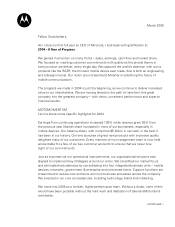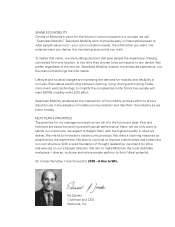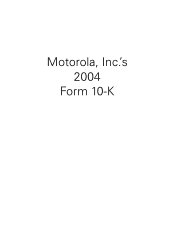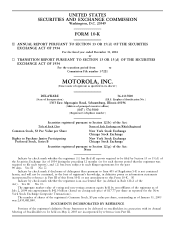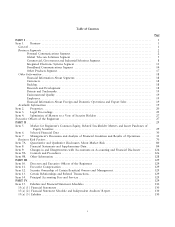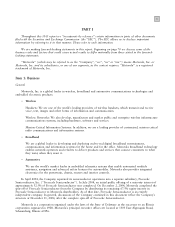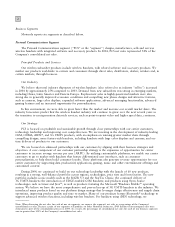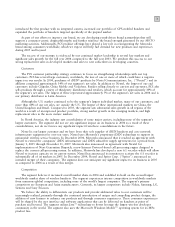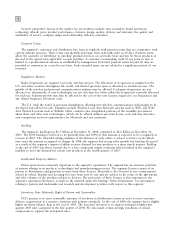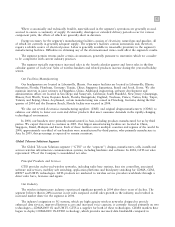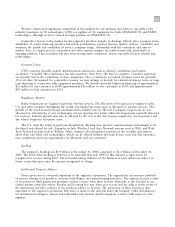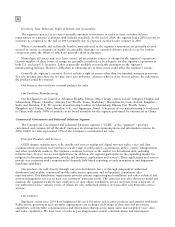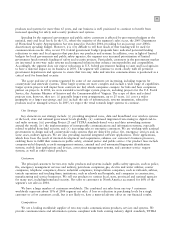Motorola 2004 Annual Report Download - page 11
Download and view the complete annual report
Please find page 11 of the 2004 Motorola annual report below. You can navigate through the pages in the report by either clicking on the pages listed below, or by using the keyword search tool below to find specific information within the annual report.
3
introduced the Ñrst product with an integrated camera, increased our portfolio of GPS-enabled handsets and
expanded the portfolio of handsets targeted speciÑcally at the prepaid market.
As part of our eÅorts to improve our brand, we are developing youth-driven brand partnerships that will
support a consumer-centric design philosophy and further reinforce the brand strength generated by our MOTO
marketing activities. Additionally, PCS product oÅerings have played a key role in reinvigorating the Motorola
brand among consumers worldwide, which we expect will help fuel demand for new products and experiences
during 2005 and beyond.
The success of our strategy is evidenced by our continued market leadership in several key markets and
signiÑcant sales growth for the full year 2004 compared to the full year 2003. We attribute this success to our
strong replacement sales in developed markets and sales to new subscribers in developing countries.
Customers
The PCS customer partnership strategy continues to focus on strengthening relationships with our top
customers. PCS has several large customers, worldwide, the loss of one or more of which could have a negative
impact on our results. In 2004, purchases of iDEN» products by Nextel Communications, Inc. (""Nextel'') and its
aÇliates comprised approximately 14% of our segment's net sales. In addition to Nextel, the largest of our end
customers include Cingular, China Mobile and Vodafone. Besides selling directly to carriers and operators, PCS also
sells products through a variety of third-party distributors and retailers, which account for approximately 30% of
the segment's net sales. The largest of these represented approximately 5% of the segment's net sales in 2004 and is
our primary distributor in Latin America.
Although the U.S. market continued to be the segment's largest individual market, many of our customers, and
more than 60% of our net sales, are outside the U.S. The largest of these international markets are China, the
United Kingdom and Brazil. Compared to 2003, the segment saw substantial sales growth in all regions of the
world as a result of an improved product portfolio, strong market growth in the emerging markets, and high
replacement sales in the more mature markets.
In North America, the industry saw consolidation of some major carriers, including some of the segment's
largest customers. The segment did not see any signiÑcant impact on its business in 2004 as a result of these
consolidations, nor do we foresee any signiÑcant impact from these consolidations in the future.
Nextel is our largest customer and we have been their sole supplier of iDEN handsets and core network
infrastructure equipment for over ten years. Nextel uses Motorola's proprietary iDEN technology to support its
nationwide wireless service business. In December 2004, Motorola announced that it reached an agreement with
Nextel to extend the companies' iDEN infrastructure and iDEN subscriber supply agreements for a period from
January 1, 2005 through December 31, 2007. Motorola also announced an agreement with Nextel for
implementation of Next Generation Dispatch, a new Internet Protocol-based call processing engine designed to
replace the current call-processing system. In addition, Motorola has developed a new 6:1 vocoder which will allow
Nextel to increase capacity on its current system. Nextel has announced its intention to activate the 6:1 vocoder in
substantially all of its markets in 2005. In December 2004, Nextel and Sprint Corp. (""Sprint'') announced an
intended merger of their companies. The segment does not anticipate any signiÑcant impact to its business in 2005
as compared to 2004 as a result of this merger.
Competition
The segment believes it increased overall market share in 2004 and solidiÑed its hold on the second-largest
worldwide market share of wireless handsets. The segment experiences intense competition in worldwide markets
from numerous global competitors, including some of the world's largest companies. The segment's primary
competitors are European and Asian manufacturers. Currently, its largest competitors include Nokia, Samsung, LG,
Siemens and Sony Ericsson.
We believe the ability to diÅerentiate our products and provide additional value to our customers will be
increasingly realized, primarily through the continued introduction of unique and compelling product designs, the
addition of new features to enhance our products and through consumer experiences. These consumer experiences
will be shaped by the user interface and software applications that can be delivered on handsets at point of
purchase and beyond. The segment utilizes Java
TM
technology to better leverage the largest wireless developer
community in the world. The segment also uses the Microsoft Windows Mobile
TM
operating system for its MPx
product line.



